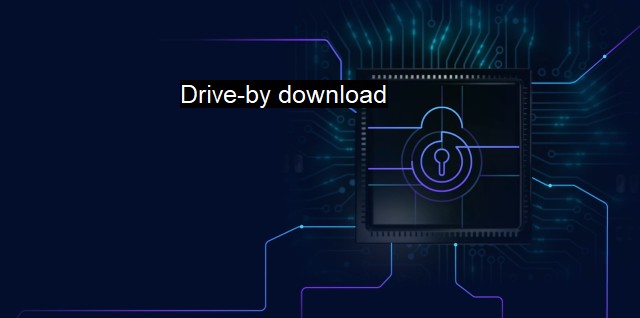What is Drive-by download?
Preventing Cyber Attacks: Understanding the Threat of Drive-By Downloads and How to Stay Protected
Drive-by download is a common term associated with the field of cybersecurity. This term refers to the unintended download of malware or malicious software from a website, which occurs unknowingly to the user. A drive-by download can happen simply by visiting a compromised web page, clicking a deceptive popup, or even hovering over an infected advertisement. Such actions work as triggers for silent and malicious downloads wherein potentially harmful software is installed onto the user's system without their notice or permission.Cybercriminals often exploit vulnerabilities within popular web browsers, plugins, and operating systems. They typically use these subordinate routes to deploy unwanted software onto the user's device. This evasion-based approach is what sets drive-by downloads apart from other forms of infection that may require user interaction or knowledge. They pose significant threats because of their covert installations.
Where a user’s daily activity includes regular use of the internet, conventional security precautions alone might not be sufficient. Thus, it's of utmost importance that users adopt stringent and updated security protocols to keep their systems safe. Having robust protections in place such as using updated antivirus software can significantly reduce susceptibility to drive-by downloads and associated threats.
In terms of antivirus protection against drive-by downloads, prevention is better than cure. Antivirus software should ideally be equipped with real-time protection. This feature enables instant detection and blockage of potentially harmful downloads before they can establish themselves onto systems.
The basis of preventing such kind of a cyberattack is to be able to identify and block harmful scripts from executing in the browser environment. Most modern antivirus software offer browser extensions which provide an additional layer of security. Currently, there are security hardware and software that neutralize the threats posed by drive-by download attacks by detecting, preventing, and deleting malware proactively.
Another significant feature that antivirus programs should adopt is the automatic scanning of emails and attachments. It mitigates risks involved via email drives which are another significant contributor to stealth malware installations.
Most high-quality antivirus software utilize strong malware signatures and heuristic behavior detection to scrutinize and mitigate potentials of malicious activities. Malware signatures enable the detection of known threat elements, while behavior detection highlights programs or files showing abnormal behavior, flagging them as potential threats.
Antivirus software often provides an option for periodic system scans. This ensures active vigilance and constant monitoring of potential threats and a system-time update on the health of one's device.
In terms of cybersecurity measures, regularly updating software and systems can't be emphasized enough. It's vital to keep operating systems, browsers, plugins, and all applications updated to ward off cybercriminals leveraging unfixed vulnerabilities.
Even with these precautions in place, users still need to remember that technological advances would likely perpetuate new threat vectors. Drive-by downloads represent just a fraction of the total cybersecurity threats faced today. It is the responsibility of the user to use the internet responsibly to avoid falling victim to such stealth attacks.
Drive-by downloads pose a considerable threat to cybersecurity. While it is frightening to think that visiting a website or clicking a link can lead to a serious malware infection, users armed with proactive cybersecurity tools and practices are well-short of such fears. Maintaining a reasoned skepticism about clicking unknown links, using up-to-date antivirus software with adequate security features, staying vigilant about the software updates are all foundational steps in thwarting drive-by download attacks and establishing safer browsing practices.

Drive-by download FAQs
What is a drive-by download attack?
A drive-by download attack refers to the incident when malicious software is automatically downloaded onto a user's computer or mobile device after visiting a particular website or clicking on a malicious link.How do drive-by download attacks work?
Drive-by download attacks often exploit vulnerabilities in web browsers or other software applications that are not updated or patched. Attackers may also use social engineering tactics to trick users into clicking on malicious links or downloading harmful attachments.How can I protect myself from a drive-by download attack?
To protect yourself from a drive-by download attack, ensure that your operating system and software applications are always up to date with the latest security patches. Use a reputable antivirus software that can detect and block malicious downloads. Additionally, be cautious when clicking on links, downloading attachments or visiting unfamiliar websites.What should I do if I suspect a drive-by download attack?
If you suspect a drive-by download attack, disconnect your computer or mobile device from the internet immediately. Scan your device using antivirus software to detect and remove any malicious files. Consider resetting your device to factory settings and changing all passwords related to financial and sensitive personal information. Lastly, report the attack to your IT department or cybersecurity professionals.| | A | | | B | | | C | | | D | | | E | | | F | | | G | | | H | | | I | | | J | | | K | | | L | | | M | |
| | N | | | O | | | P | | | Q | | | R | | | S | | | T | | | U | | | V | | | W | | | X | | | Y | | | Z | |
| | 1 | | | 2 | | | 3 | | | 4 | | | 7 | | | 8 | | |||||||